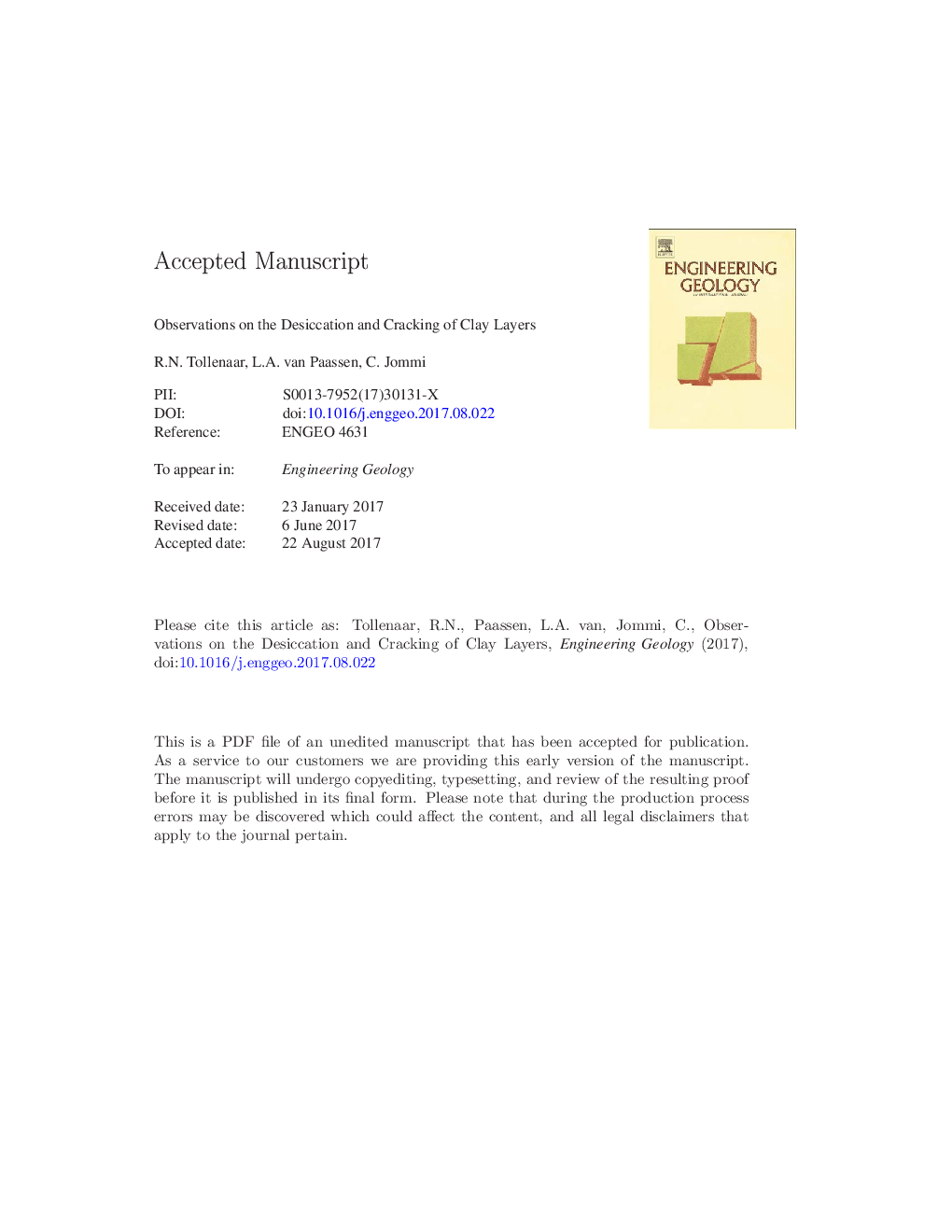| کد مقاله | کد نشریه | سال انتشار | مقاله انگلیسی | نسخه تمام متن |
|---|---|---|---|---|
| 5787422 | 1641755 | 2017 | 30 صفحه PDF | دانلود رایگان |
عنوان انگلیسی مقاله ISI
Observations on the desiccation and cracking of clay layers
ترجمه فارسی عنوان
مشاهدات در مورد خشک شدن و ترک خوردگی لایه های خاک رس
دانلود مقاله + سفارش ترجمه
دانلود مقاله ISI انگلیسی
رایگان برای ایرانیان
کلمات کلیدی
خشک کردن رس خشک کردن خاک، پخش شکستگی، ترک خوردگی خاک،
ترجمه چکیده
آبهای زیرزمینی و دریاچه ها در مناطق دلتا لایه های کم عمق نیاز به تعمیر و نگهداری دارند. اغلب این رسوب ها در زمین قرار می گیرند، جایی که آنها از طریق ترکیبی از زهکشی، تثبیت و تبخیر اجازه داده می شوند. هنگامی که ترک ها در طول خشک شدن رشد می کنند، پاسخ فیزیکی خاک به واسطه تغییرات در قدرت کلی، سختی و نفوذ پذیری مواد تحت تاثیر قرار می گیرد. برای شناسایی چگونگی شکل گیری و انتشار ترک ها، یک سری آزمایش ها در یک محیط آزمایشی کنترل شده بر روی نمونه های خمیر خاک رس خشک تحت شرایط مختلف اولیه و مرزی انجام شد. نتایج این مطالعه نشان می دهد که نتایج حاصل از مدل های مقیاس های آزمایشگاهی باید با دقت تجزیه و تحلیل شوند، زیرا آنها به منطقه و ضخامت نمونه بستگی دارد. با این حال، ویژگی های مشترک از تست های مختلف می تواند شناسایی شود، که بیشتر مربوط به رفتار درونی مواد است. به عنوان مثال، محتوای آب که در آن ترک ها شروع می شود، بیشتر به میزان خشک شدن بستگی دارد و نه تنها در محتوای اولیه آب. به طور معمول برای خاک های خاکستر مورد بررسی قرار گرفته است، مقدار آب ترک خورده بسیار بالاتر از حد انقباض و در برخی موارد حتی بالاتر از حد مایع است. ترک خوردگی می تواند در هر جایی یک نقص رخ دهد، اما مشاهده شد که آنها در جهت افقی زیر سطح خاک پخش می شود. در سطح خاک آنها تمایل دارند به طور عمود بر یکدیگر متقاطع شوند، و این نشان می دهد که آنها توسط رژیم تنش کششی تحت سلطه قرار می گیرند. تنش برشی نیز بر پاسخ تاثیر می گذارد، اما عمدتا در نزدیکی مرزهای نمونه، به علت اصطکاک رابط است.
موضوعات مرتبط
مهندسی و علوم پایه
علوم زمین و سیارات
مهندسی ژئوتکنیک و زمین شناسی مهندسی
چکیده انگلیسی
Waterways and lakes in low-lying delta areas require regular dredging for maintenance. Often these sediments are placed on land, where they are allowed to ripen through a combination of drainage, consolidation and evaporation. When cracks develop during desiccation, the physical response of the soil is affected by changes in the overall strength, stiffness and permeability of the material. To better identify how cracks form and propagate, a series of tests was carried out in a controlled laboratory environment on samples of drying clay slurries under different initial and boundary conditions. The outcomes of this study indicate that the results from laboratory small scale models must be carefully analyzed, as they depend on the area and the thickness of the sample. However, common features from the different tests can be identified, which are mostly related to the intrinsic behavior of the material. For instance, the water content at which cracks initiate depends mostly on the drying rate and not only on the initial water content. Typically for the clayey soil investigated, the cracking water content is well above the shrinkage limit and in some instances even above the liquid limit. Cracks can form anywhere a defect is encountered, but it was observed that they propagate in horizontal directions below the soil surface. On the soil surface they tend to intersect with each other perpendicularly, suggesting that they are dominated by a tensile stress regime. Shear stresses also influence the response, but mainly near the boundaries of the samples, due to the interface friction.
ناشر
Database: Elsevier - ScienceDirect (ساینس دایرکت)
Journal: Engineering Geology - Volume 230, 29 November 2017, Pages 23-31
Journal: Engineering Geology - Volume 230, 29 November 2017, Pages 23-31
نویسندگان
R.N. Tollenaar, L.A. van Paassen, C. Jommi,
